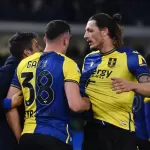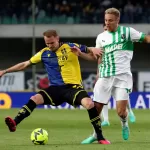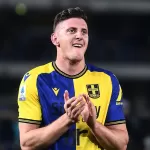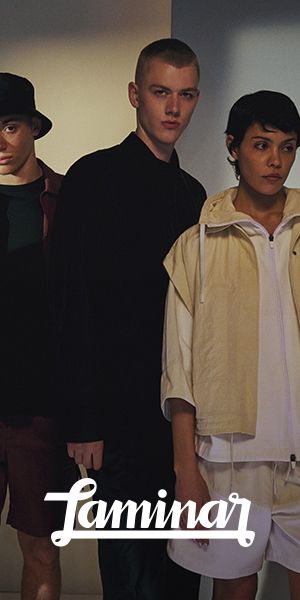
'A jersey is like the flag of a state', behind the scenes at Hellas Verona
We had Niccolò Vallenari of Unaforesta tell us about the Scaligera team's 120th anniversary celebrations
April 11th, 2023
Saturday afternoon saw a memorable match at the Bentegodi, with flags flying to commemorate the 120th anniversary of the Verona club. A milestone that was also celebrated by a special jersey that Macron had designed with Verona's creative agency Unaforesta, which sold out immediately. And if the atmosphere in the stands was one of grand occasions, then on the pitch came the feat that gave the Gialloblu renewed hope. In a stadium filled to capacity, Hellas sprinted past Sassuolo and overturned a two-goal deficit in the last ten minutes of the match, thanks in part to an unforgivable error by Consigli in stoppage time to gift Gaich the winning goal.
Throughout the season, Hellas Verona paid great attention to its aesthetic profile, working on both the Macron-branded kits and the communication, thanks to the work of the Unaforesta agency and Studio Fantastico, a unit dedicated to art direction, branding and content production. The result of this happy collaboration was the anniversary jersey, an increasingly strong trend in today's football scene, divided into two halves by the two corporate colours and featuring a redesigned crest inspired by Verona's history. To mark the occasion, we had the pleasure of talking to Niccolò Vallenari, Partner & Account at Unaforesta, about the collaboration with Verona, the evolution of football team design and the future of kits.
How did the collaboration with Hellas Verona start?
The collaboration with the club started in the 2020/21 season with a digital marketing and e-commerce consultancy project that we are still following. Over these three years, the relationship has steadily evolved, to the point where our creative department Studio Fantastico is also involved. Last year it was the campaign for the launch of the 2022/23 away kit, in these months the project for the club's 120th anniversary.
What path guided you in this redesign of the Hellas Verona jersey and logo?
Let us start with a premise that cannot be taken for granted: this project was born and developed in collaboration with the club and, in particular, with the marketing and product team. From the beginning, it was clear that the club wanted to consolidate a 120-year relationship between the city and the club. As Veronese and football fans, we were already very familiar with the history of the team and the shirts used throughout the different seasons, but when Hellas Verona gave us the opportunity to access their historical archive, we did not ask twice. During the visit we had the opportunity to learn many new anecdotes and see a number of memorabilia and products other than match jerseys that we would never have seen 'live' and which were very useful to us on a creative and design level.
How do you combine all the components (historical, emotional and aesthetic) of a jersey into one big project?
It's a journey that starts from afar, first and foremost from a deep passion for football and all its nuances. Knowing this world and its evolutions over time, it was fundamental for us to respect the history of the team and the bond with its fans on the one hand, and to bring the project into the present by taking the jersey out of the pitch on the other.
In the research and development process, the dialogue with the club was fundamental. It was important for us to work in symbiosis with the people who work with the team every day and who have lived these colours from the inside for years. The design of the jersey dates back to the time of the club's foundation and, on such an important anniversary, recalls the beginnings of the then Hellas (even if the colours were curiously black and white at the time). The launch campaign, which is very fashionable and cinematic and tells a strong story, is certainly the part of the design that is more oriented towards the present and follows a trend that is now well established. To unite all these sometimes contradictory components, the selection of the working team was fundamental, a mix of professionals who experience football first-hand and enthusiasts with connections to the city and the club, without whom we could not have realised a work of this magnitude.
Which of the many details hidden on the jersey is your favourite and what significance does it have for you?
There are actually two details that are particularly close to our hearts. The first is inserted into the label on the collar and carries one of the most famous refrains of Verona fans: 'Sosteniam la più grande squadra che il mondo ha visto mai' ('Let us support the greatest team the world has ever seen'), an exaggeration that reflects well the passion of Gialloblù fans. This is also the only refrain that mentions two names the club has had over the years: 'Hellas Verona AC' and 'Verona Hellas'.
The second is the label on the underside of the jersey, reminiscent of the one found on the team's jerseys in the mid-1990s, which has a very special history: in 1995, then-president Alberto Mazzi restored the old name Hellas Verona Football Club, which had been lost to bankruptcy a few years earlier, and had a label with the words Hellas 1903 sewn onto the sleeve, in memory of the club's glorious history.
What does it mean for you to work with one of the city's landmarks?
One clarification is important: the studio is based in Verona, but the origins and football 'faith' of its members are highly diverse. To work with such an important football club, so deeply rooted in the city, is an honour for us and means a lot, also in terms of responsibility.
What do you think is special about the relationship with this area when you have to develop cooperations or work together?
In this case, the studio's natural connection to the region was certainly an advantage for us. In general, it is important for us to study and get to know the people on the other side. In this case it was even more important: the area we wanted to work in was and is very sensitive "because of" the love and passion the fans have for the colours and the origin of the team they belong to. Knowing the history and the evolution that Hellas Verona has gone through over the years has certainly helped us to tackle the different aspects of this project a little better.
The jersey was sold out immediately and on Saturday it will finally be worn by the players on the pitch. A success in every respect, which underlines the goodness of your work and this kind of cooperation.
Do you think this trend will intensify in the next few years?
It is important to share this important result with the whole team, which involved not only Studio Fantastico, but also the Hellas Verona marketing and product team, the shirt sponsors and the technical supplier Macron. The teamwork between everyone involved was crucial to the success of the project.
We believe that this trend is still developing and that it is indeed still in its early stages: Clubs will open up more and more to external collaborations and in this process clubs like Juventus, Venezia, Inter, Red Star FC, PSG and many others have certainly led the way. On this path, it will be crucial to protect all stakeholders, first and foremost the fans and supporters who are the beating heart.
What has happened to the football jersey and how do you think the football aesthetic has evolved?
The whole study for this project started from a very similar question and before we came to the design of the jersey, it was crucial for us to be able to give an answer to this question. A club's shirt, together with its crest, is the most important and representative image of thousands of people and this visceral bond must always be the starting point for any project related to the world of football and sport in general. The most obvious comparison is certainly that in which the logo of a team is placed next to the flag of a state: Timeless values are linked in this colour combination. Certainly, the football jersey as an object outside the stadium today experiences the moment of maximum presence and visibility, even if it 'walks' a fine line between its intrinsic value and the economic value it represents for the clubs.
In recent years, we have noticed that the design of jerseys is increasingly blinking at the fashion world and the macro trends that animate it: if we look at the template used by Nike this season, the reference to the jerseys from the mid-'00s is clearly visible. In terms of our work, the biggest opportunities on a creative level are certainly in the third/fourth jerseys or special projects, where clubs are the first to enter into more proactive collaborations and/or experiments: From our point of view, these can be the real field in which the aesthetics of this world can develop.










































.png)


.jpg)





















